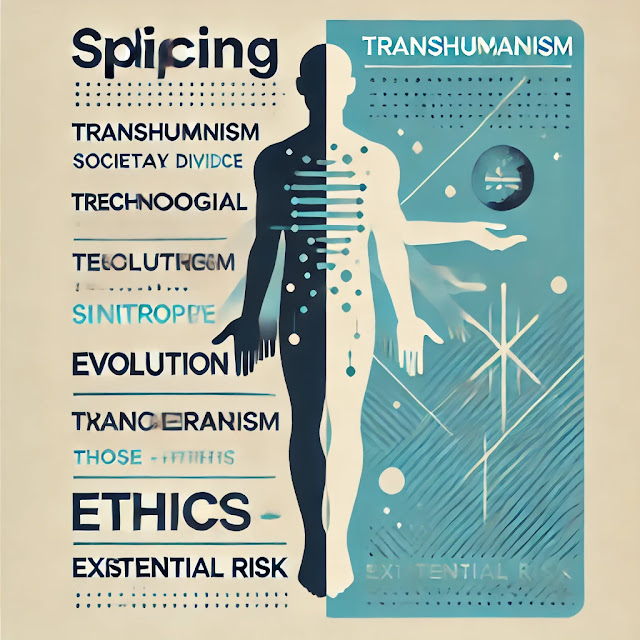Advancements in technology and science could potentially (like 30 years ago) lead humanity towards significant evolutionary changes - often referred to as 'splicing'.
In this hypothetical scenario, one group might be said to "go to the future," symbolizing progress or evolution. The other group is left behind or "extinct", representing stagnation or decline. This metaphorically captures the essence of trans-humanist ideals - embracing change and innovation while acknowledging potential challenges and ethical considerations.
The idea of two divergent paths—where one group evolves by embracing technology and the other faces extinction—resonates deeply with transhumanist thought. In transhumanism, the concept of splicing refers to merging human biology with advanced technologies, allowing for enhancements that could radically alter human existence. This can include genetic modifications, neural interfaces, cybernetic enhancements, or even merging with artificial intelligence (AI). The metaphor of one group going "to the future" and the other becoming "extinct" touches on several key transhumanist ideas:
- Technological Evolution:
Transhumanists believe that humanity is on the brink of an evolutionary leap driven by technology. The concept of splicing speaks to the integration of biological and technological systems, fundamentally altering human capabilities. This could mean enhancements in cognitive function, lifespan, physical abilities, or even transferring human consciousness into digital systems—what some call digital immortality. Those who embrace this future might transcend current human limitations, becoming post-human or even near-immortal.
Reference: Ray Kurzweil's concept of the Singularity predicts a moment when artificial intelligence surpasses human intelligence, leading to an explosion of progress and transformation for humanity .
- The Dividing Line:
In this future, there’s an implicit divide between those who embrace change and those who resist. This mirrors a central transhumanist concern: what happens to individuals or societies that choose not to adopt technological advancements? There’s a fear that they could be left behind, unable to compete or thrive in a world dominated by enhanced humans.
Reference: Max More, a leading transhumanist philosopher, discusses this in his writings on Extropy, where he argues that embracing change and growth is essential to avoid stagnation and decline . This dynamic can be seen in the metaphor of the "extinct" group—those who resist technological evolution could become marginalized or even obsolete.
- Ethical Considerations:
The metaphor raises ethical questions about the nature of progress and who benefits from it. If only a select group can afford or access advanced technologies (such as genetic splicing or AI interfaces), it risks creating a societal divide between the enhanced and the non-enhanced. The "extinction" of one group could represent a moral and ethical extinction as well—where those who cannot evolve are left without power or agency.
Reference: Yuval Noah Harari in Homo Deus discusses the rise of a "techno-human elite" that could potentially use technology to create a new species of humans, leaving the rest of humanity in the dust .
- Splicing and the Future of Humanity:
The idea of splicing—whether through genetics or AI—embodies the heart of transhumanism: transforming the human condition. Genetic splicing could allow humans to eliminate diseases, enhance physical or mental capacities, or even engineer traits for longevity. This transformation could represent the "going to the future" group, achieving a form of digital or biological immortality.
Reference: CRISPR gene-editing technologies are already pushing the boundaries of what is possible with human genetics. While we are far from a fully spliced post-human species, the ethical and philosophical questions these developments raise are central to the transhumanist vision .
- Existential Risk for the Unenhanced:
In contrast, those who reject these technological transformations could face existential risks. In a world where others are vastly superior in intelligence, strength, or longevity, those who remain unenhanced might find themselves increasingly irrelevant or unable to compete for resources, power, or survival.
Reference: The idea of technological inequality is explored by Nick Bostrom in his work on superintelligence, where he warns that the rise of vastly superior beings (whether AI or enhanced humans) could pose an existential threat to those left behind .
Conclusion:
The metaphor of one group going to the future while the other goes extinct encapsulates a central tension within transhumanist thought. While technological evolution offers immense potential for human advancement, it also presents profound risks—both for those who cannot keep up and for society as a whole. The ethical dilemmas, societal divides, and existential risks raised by these possibilities must be carefully considered as humanity stands on the brink of its next evolutionary step. Transhumanism, in all its complexity, is a journey toward the unknown, with the potential for both great progress and deep challenges.








0 Comments